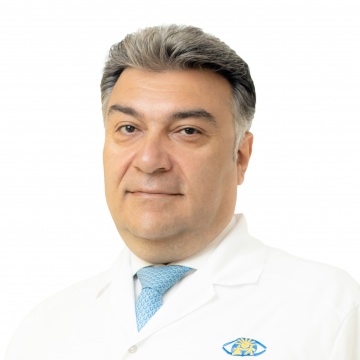In 85% of cases of strabismus (regardless of whether it is congenital or acquired; permanent or periodic), the surgical stage in treatment is required for full rehabilitation.
Children's strabismus is not a cosmetic problem. The absence of a symmetrical position of the eyes leads to deep functional disorders of the visual system. Moreover, strabismus may not be the primary condition but the result of another, sometimes very serious disease of the visual organ.
90% of children with strabismus do not perceive the 3D format.
Why do we need to treat strabismus?
We have developed the Strabo program for mathematical modeling of strabismus surgery.
We take into account the individual characteristics of the child, the interpupillary distance, refraction of the eyes, the angle of strabismus, and we can calculate the angle of the eye rotation and determine the number of operations in the case of strabismus that this child needs to make its gaze straight with pinpoint precision. Using this program allows not only precise calculating the scope of operations but also minimizing the number of required operations, if possible.
We have developed high-frequency radio-wave surgery for strabismus. This is the latest, safest, and most precise technology in the world for oculomotor disorders surgery, which is recognized by our colleagues, children's eye surgeons abroad.
We have abandoned the use of traditional scalpels and scissors in favor of radio-wave technologies. We don't cut or sew anything, we preserve the structures of the eye.
Radio-wave high-frequency surgery allows:

Igor Erikovich Aznauryan
Doctor of Medical Sciences, Professor, Academician of the Academy of Medico-Technical Sciences, Pediatric Surgeon, Pediatric Ophthalmologist, founder and Head of Yasniy Vzor Children's Eye Clinics in Russia.

Viktoriya Olegovna Balasanyan
Candidate of Medical Sciences, Deputy Head of Scientific and Clinical Affairs of Yasniy Vzor Children's Eye Clinics, Head of the Surgical Department.
We are very proud that our system of surgical treatment of strabismus, based on the minimal trauma rate, using the method of mathematical modeling and radio-wave surgery, has received recognition not only among our many patients but also in the professional environment, both in Russia and abroad.
We strive to make sure that this innovative surgery becomes available to everyone who needs it over time.
Unfortunately, the cost of all advanced technologies is higher than in conventional surgery. But we really want all children and adults who are faced with such a serious systemic pathology as strabismus to have the opportunity to use these up-to-date methods, regardless of the status of the family and its income.
That is why we have created a technology that allows reducing the cost of the operation significantly without serious damage to the precision of the operation. This cost-effective technology is very close in essence to the expensive one. At the same time, it has elements of the old and widely used technology but these elements do not contradict our effective methodology.
The head of the clinic on Sokol, Dr. Magomed Isayevich Uzuyev, a student of the founder of our clinic, Igor Erikovich Aznauryan, performs operations with microsurgical scissors, also using the method of mathematical modeling and calculation of the operation developed by us for the maximum precision. This method is applicable for dosing and performing operations only in the case of converging strabismus.
When we are contacted with such eye pathology as strabismus, many people cannot imagine that there are more than 20 types of strabismus. There is a special type of this disease, paralytic strabismus, among them. It is quite rare and it is not treated everywhere. Paralytic strabismus is strabismus, in which the movements of the eyeball are restricted in one or more directions of vision. Three nerves are responsible for the contraction of the oculomotor muscles and a violation on the part of one of them leads to limited mobility of the eyeball and the development of paralytic strabismus. The most severe type of this disease is paresis (paralysis) of the oculomotor nerve. With oculomotor nerve paresis, it is impossible to orient the affected eyeball to the object of fixation. This leads to serious underdevelopment of the visual system. Do we treat paresis? The answer is yes! We even recover the mobility of the eyeball, although many skeptics may say that this is impossible.
According to statistics, one in 403 babies is born with congenital strabismus! What does it mean? This means that the eyes of this little human are initially deprived of the ability to develop correctly and it is required to perform an operation to correct strabismus before the age of 3-4 years. It is up to this age that the visual system is finally formed and it is important to influence the process now when the eyes of a small human are still on the way of their development.
The task of strabismus surgery is to give the eyeballs the correct position for the subsequent development of binocular (double-eyed) and stereoscopic (three-dimensional) vision.
One of the experimental methods of surgical treatment is botulotoxin injections into the oculomotor muscles. They are used for the treatment of both adults and children.
The mechanism of this method is that the muscle is turned off by injection and stops "pulling" the muscle to its direction.
Reducing the angle of strabismus with such injections is not permanent, and the angle will return to the original after the drug effect ends (3 to 6 months).
The existing operation dosage tables do not always allow achieving a straight eye position precisely.
This method of treatment of strabismus also assumes complications. It was found that after injection of botulotoxin into the oculomotor muscle, the function of tear production worsens, which may cause the emergence of the "dry eye" syndrome. This syndrome is manifested by a constant feeling of sand, dryness, and pain in the eyes. Moreover, the injection technique itself may lead to complications. The literature describes cases of retinal detachment and hemorrhage in the vitreous after the injection of botulotoxin in extraocular muscle.